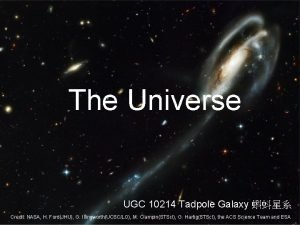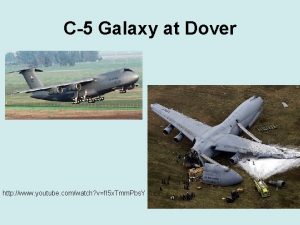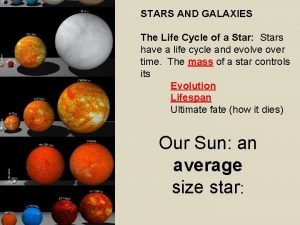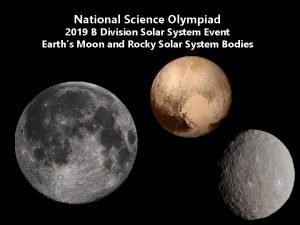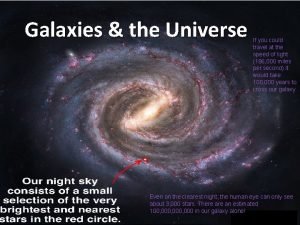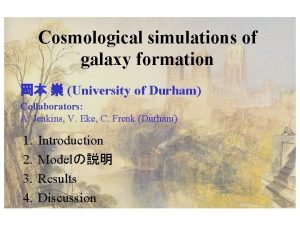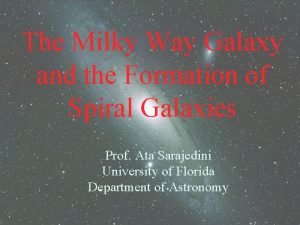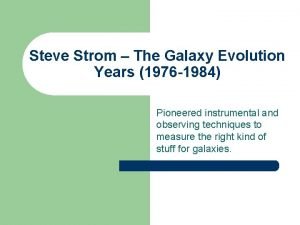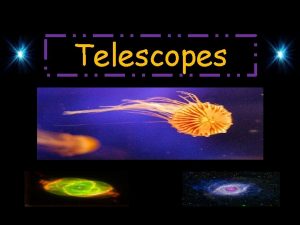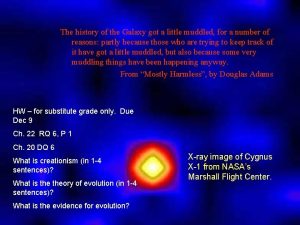Galaxy History how we got here Galaxy History

























- Slides: 25

Galaxy History – how we got here

Galaxy History – how we got here • Stars evolve, therefore so do galaxies • We parts of a rich history – they grow, starburst, acquire gas, lose gas, change chemistry, shut down starbirth, interact with central black holes • Contemporary hints – the galactic fossil record • Cosmic time machine – we can see their past! • We must be wide-ranging in space and energy • Tools: Hubble, Chandra, Spitzer, GALEX, ground -based telescopes – and brains

Stars have life cycles…

…so galaxies do too. Some clues are found in the contemporary fossil record.

…so galaxies do too. Some clues are found in the contemporary fossil record. Elliptical galaxy: only old stars, no cold gas to make more

…so galaxies do too. Some clues are found in the contemporary fossil record. Elliptical galaxy: only old stars, no cold gas to make more Spiral galaxy: all ages present, stars still formed in gas -rich disk

Waiting for the light – the Universe is a one-way time machine 2. 6 seconds round trip

8 minutes 75 minutes

4. 3 years 15, 000 years

60 million years 2 billion years

Galaxy collisions, mergers, and starbursts


Abell 2125 -C 153 A galaxy loses its gas



Across the spectrum - now Far. IR Mid. IR near. IR opt UV far. UV X-ray gamma GALEX Spitzer WMAP INTEGRAL FUSE Hubble Akari Chandra

A panchromatic view spiral galaxy M 81 ROSAT GALEX Kitt Peak Spitzer VLA


+ + San Pedro Martir 115° 27´ 49 W 31° 02´ 39 N 2, 830 m ++ + +


A sky survey for the new millennium • • • Potentially 4000+ objects per exposure Uniquely wide field for 6. 5 -meter telescope Uniquely wide slice of spectrum at once Add time dimension to Sloan survey galaxies Study internal galaxy structure UA involvement in project planning – at the table pending fundraising!

Even very distant galaxies can often be mapped from the ground Kitt Peak/Hubble, optical NASA IR telescope, IR

N=270

Galaxy history • Downsizing (I love the crash of a theory…) • Central black holes are ubiquitous and may regulate surrounding starbirth • Large galaxies grow at the expense of dwarfs • Galaxies have long interacted with their surroundings – gas, other galaxies…

Looking forward to looking back • • Chemistry of young galaxies How did these enormous black holes grow? What were the first stars like? Why do some galaxies shut down star formation, and others host massive rapid bursts?
 Elliptical spiral and irregular
Elliptical spiral and irregular Present simple exercises intermediate
Present simple exercises intermediate Present simple tense razlaga
Present simple tense razlaga Family and friends 2 unit 2 lesson 6
Family and friends 2 unit 2 lesson 6 Tkam quotes quiz
Tkam quotes quiz There's a place where streams of grace
There's a place where streams of grace I got peace like a river
I got peace like a river Jhu
Jhu Metaomic
Metaomic Galaxy.einet
Galaxy.einet Galaxy.einet
Galaxy.einet Youtube
Youtube Disc filters galaxy 4 spin klin series
Disc filters galaxy 4 spin klin series Galaxy definition
Galaxy definition Life cycle of galaxies
Life cycle of galaxies Science olympiad solar system
Science olympiad solar system System galaxy tech support
System galaxy tech support Are the stars we see at night in our galaxy
Are the stars we see at night in our galaxy Galaxy classification
Galaxy classification Galaxy formation
Galaxy formation Virtual galaxy
Virtual galaxy Canis major dwarf galaxy
Canis major dwarf galaxy Steve's galaxy (legacy)
Steve's galaxy (legacy) Presentvsimple
Presentvsimple Why do disk stars bob up and down as they orbit the galaxy?
Why do disk stars bob up and down as they orbit the galaxy? Article galaxy scholar
Article galaxy scholar







